CHAPTER III
SURGING AHEAD, 1880-1900
Although the eighties were to see some rather spectacular advances in many fields of endeavor, the decade did not get off to a very good start, for the year of 1881 was the year of the great fire that nearly wiped out the west side of Main Street and much of the business section of Park Street. How the fire started is a moot question—there have been several versions, but the most reasonable seems to be that it started on Park Street from an overheated stove in a building once owned by Going Hathorn. It swept through Vickery’s store and was fanned eastward to make a clean sweep of the business blocks of upper Main to stop just short of A. H. Cornforth’s store. When the last embers had been extinguished, the area presented a bleak, discouraging picture with its charred timbers and its blackened chimneys standing stark and naked like ghostly sentinels.
There is a saying that we grow strong in adversity. That was certainly true in 1881. The last flame had hardly been extinguished before the charred rubble was being removed and plans were in the making for a new and better business area.
PITTSFIELD ADVERTISER
About the first effort in restoration was the decision to build an outstanding municipal building and the progress made in that direction is eloquently described in the early issues of The Pittsfield Advertiser which published its first edition in April 1882. This remarkable weekly has had a most interesting history in its eighty-four years of uninterrupted publication. It has been invaluable to the writer since he became involved in this story of Pittsfield and in order that it may be of further use to those interested in local history, he has assisted in having all of its copies bound and placed on file at the library. This is as good a time as any to thank all those who have had a part in this most worthwhile project Mrs. Libby, the librarian; interested individuals; clubs and the First National Bank.
60
The story of The Pittsfield Advertiser is a fascinating one. It has throughout the years reflected the tenor of the times. It was born at the beginning of the era we have referred to as one of vigorous growth. There was the spirit of youth in the air that was inspiring to those who were fortunate enough to have been around Pittsfield at that time. Anesprit des corps existed that drove men to do things. Charles B. Haskell evidently caught some of the spirit of these times. He felt that he could help a little with a small news sheet published monthly, advertising the goods of merchants and promoting such causes as he deemed worthy. Although others had tried a similar venture in the late seventies with the Pittsfield Times and failed, Mr. Haskell had the feeling that he could make his paper succeed. How well he did succeed is a matter of record.
His first issue, four pages 8 x 11, stated in its banner head that it was DEVOTED TO THE INTERESTS OF THE BUSINESS COMMUNITY. There were plenty of ads, a few local items, a feature article concerning a fatal accident in Detroit, and a personal item which may have been inserted by the editor, since it is well authenticated that he possessed a good sense of humor. We have photographed this first edition and hope that the readers will get as much fun out of reading the ads as we did.
The next edition came out in May as promised. It was larger than the first 11 x 15½ and in addition to a fine page of local news, it included correspondence from Burnham, Detroit, Harmony, Madison, Newburg, Palmyra, Ripley, Solon and St. Albans. The front page featured a short story, the editorial page thanked the public for its warm reception of the first issue and then promoted a sales campaign that included a choice of magazines which for a small additional amount could be taken along with a years subscription toThe Advertiser. The subscription price for The Advertiseralone was 35 cents per year!
UNION HALL
It was in this issue that we find the first mention of a movement to build Union Hall. Under the heading About Town we find this historic item: We learn that at an adjourned meeting
61
of the subscribers for stock in the proposed Union Hall, held May 5th, it was voted by those present 70 shares in favor to 21 against to build without stores on Park Street, and that a committee was chosen consisting of A. P. McMaster, Wm. Dobson, and A. H. Cornforth, to nominate a building committee whenever the number of shares subscribed for shall reach 160 their report to be made to a future meeting to be called by the committee on plans and estimates.
In the June issue of The Advertiser we find this item: The number of shares subscribed for in the proposed brick building having reached 160, a meeting of subscribers for the stock was called at Engine Hall, Tuesday evening, June 6th. A building committee was chosen, consisting of T. S. Dexter. O. S. Haskell, and George H. Hunter.
In the July issue we learn that the foundation work for the new hall was let to Joseph L. Fisher, the work to be completed by August 15th.
In the August and September issues the work is described as progressing well. The October edition announces that H. A. Morrell has finished making his third kiln of bricks. This will make 600,000 bricks he has manufactured since June 12th and a large portion of them has gone into the construction of Union Hall, which has come along so well that the walls are now up and ready for the roof.
In December, the readers of The Advertiser were informed that the outside of Union Hall was completed and the grading finished. An immense cistern had been completed in the basement, a floor laid in the storeroom, and the engine room and lock-up nearly ready for occupancy. Workmen were then engaged building the galleries and stairs.
In January 1883 a Ladies Union Hall Club was organized and for the next year this was one of the most active organizations in the area. The Club grew rapidly and the ladies put on dances, dinners, and drives to raise money to furnish the new hall. They were most successful and climaxed their work in May with one of the grandest dedicatory programs that can be found in the whole history of Pittsfield. It went for four days and The Advertiser came out with special editions on the 15th, 16th,
62
17th, and 18th, to describe the events of the week. On the 15th, the Dramatic Club presented Octoroon and it was reviewed as one of the finest plays of the season.
On the 16th, the Grand Opening Ball was held and more than 800 tickets were sold. Special trains were scheduled from Skowhegan and Hallowell. An order of 20 dances was offered and D. M. Parks acted as Floor Director and from all reports, he did a magnificent job. On the 17th, there was a Grand Concert with artists coming from Portland and Augusta to assist the local talent. Jennie L. Coffin was a featured soprano soloist and Bertha L. Pendexter with her humorous readings was most enthusiastically received. The celebration was completed with a second Grand Ball, this time W. H. Faunce being the Floor Director. Throughout the entire week the Ladies Union Hall Club ran a fair, selling food, art work and knick-knacks, gathering in enough money to help make the hall one of the most attractive in the state.
There was a slight mishap during the proceedings. There was a case of food poisoning following the meal the evening of the Grand Concert, but after the usual dire rumors that often surround such occurrences had been allayed, all was happy again and the celebration ended in a smashing success.
The construction of Union Hall inaugurated a building boom that has seen no equal since. It seemed to personify a spirit of optimism and hope for the future of Pittsfield that spread through all phases of community life. After Union Hall came two large woolen mills, two active lumber mills, a railroad from Pittsfield to Hartland, an electric power plant, a large clothing factory, a community water works system, a sewer system, three brick blocks on the west side of Main Street as well as one fine frame store, one excellent frame block on the east side of Main Street and several other smaller shops in other parts of the business section. The fever of this building activity swept over the citizenry of the town, and during the next twenty years, residential construction averaged around twenty homes per year. Some of the finest residences in town today were built during this period. Lets examine in more detail some of this extraordinary growth.
The music had hardly died down from the last Grand Concert of the Union Hall dedication before a chorus of hammers, saws,
63
and trowels filled the air around the new G. A. R. building going up on Park Street and the modern brick block on Main Street being erected by J. C. Connor. This was a particularly fine structure, built to house two stores on the street level and offices on the second floor. The Conants moved into the stores at first and since that time it has been variously occupied by apparel stores and finally by the First National Bank. At one time there was a meat market in the basement. The same year, 1883, work was started on the Maple Grove Woolen Mill by Dennison Walker, who had dissolved his partnership with the Dobsons and was striking out for himself. This ambitious project created a piece of property that over the years has brought into Pittsfield thousands of payroll dollars to contribute materially to the prosperity of the town.
For many years it was known as the Riverside Mill and was operated by various owners strictly as a plant manufacturing quality woolens. Later Mr. Lancey Milliken purchased the property and dealt in processed wool; today it is once again a woolen mill. The G. A. R. building was completed near the end of this year and the first floor was occupied by G. E. Kimball as a pant factory.
SEBASTICOOK & MOOSEHEAD RAILROAD
For some time, there had been considerable discussion, both unofficial and official, regarding a railroad from Pittsfield through to Moosehead. Pittsfield appeared in most of these arguments in a somewhat neutral capacity. It really did not seem to make a great deal of difference to the economy of the town which direction such a road would take, although time has proved that perhaps if the road had been laid out along the East Branch of the Sebasticook, our town would have benefited more substantially. Sentimentally, the route along the West Branch offered more appeal to many for there was a warm feeling on the part of quite a few of the local citizens for the Hartland area with its Moose Pond and its hospitable Castle Harmony.
At any rate, in April 1886 it was proposed to build the first section of such a road from Pittsfield to Hartland. In July at a hearing in Hartland, it was voted to extend the road to Harmony, and in August, at a hearing in Pittsfield, it was decided to start construction at once from Pittsfield to Hartland.
64
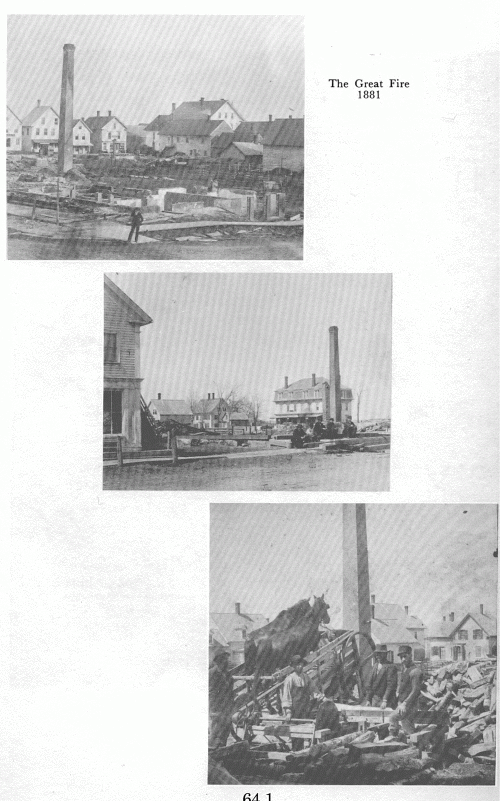
[Page 64.1]

[Page 64.2]
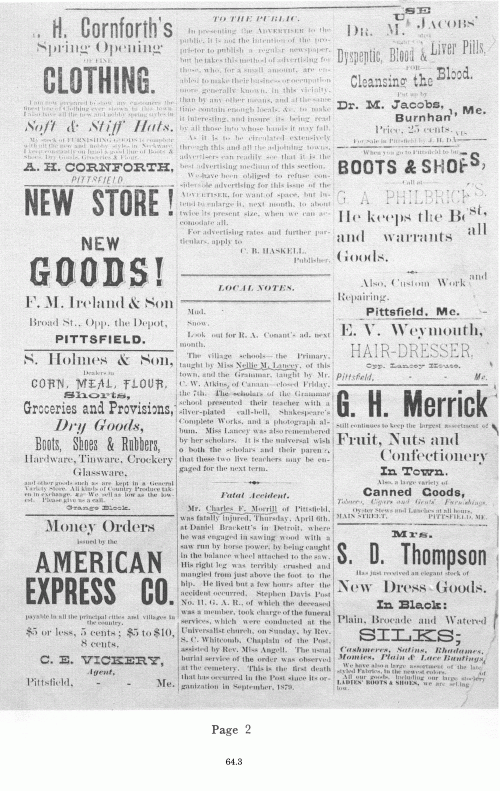
[Page 64.3]
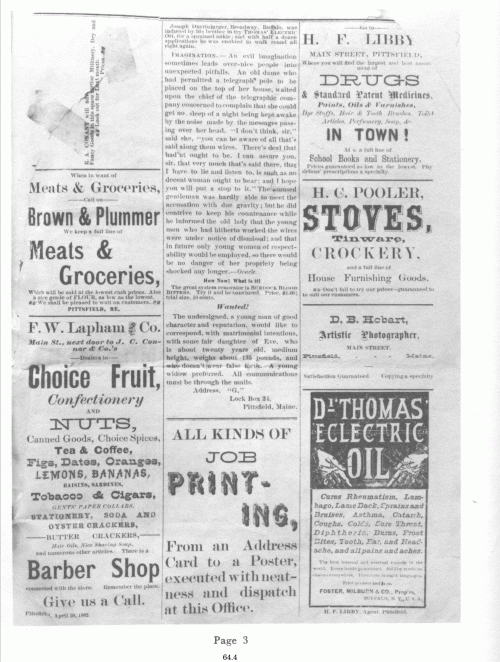
[Page 64.4]
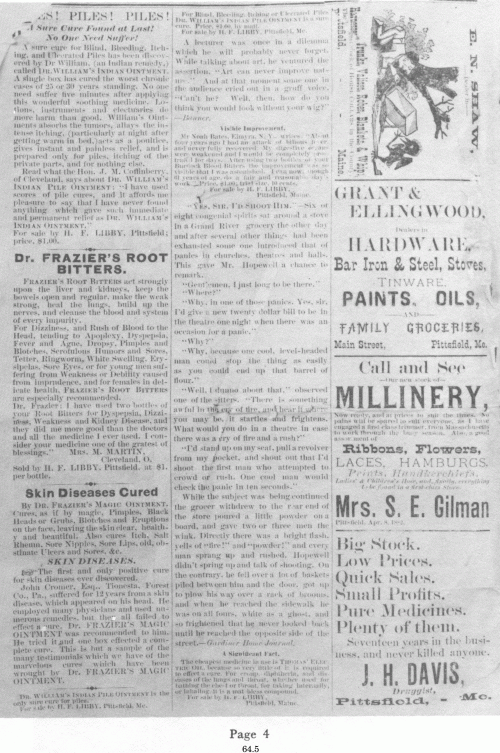
[Page 64.5]
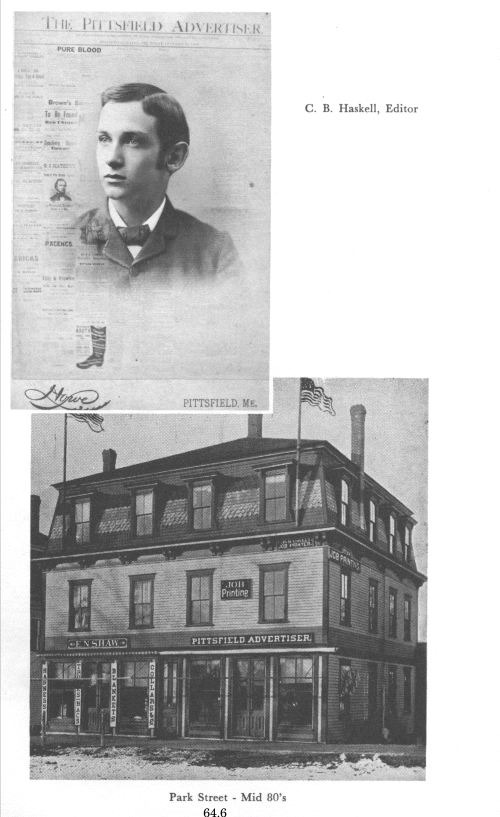
[Page 64.6]
It was one of the fastest pieces of railroad construction on record. In September, work began and reported coming along very well. In October, a large crew had completed the road bed and laid most of the rails. In November, ten weeks after the first shovel full of earth was turned, the road was opened with a great celebration in Hartland. The first freight hauled on this opening day was consigned to Linn and Shaw of Hartland and a large crowd from Pittsfield was on the train. They stayed late and many of the jubilant citizens from Hartland joined them on their return trip to Pittsfield. No record is made of how they got back to Hartland.
Pittsfield now became a busy little junction and traffic picked up considerably although minor breakdowns on the Hartland branch marred some of the trips. We read of frequent excursions to the Moose Pond region that must have been delightful. One such occasion is described in some detail as a trip to Castle Harmony by the Flower of Pittsfield’s Business Men, including Dr. H. Pushor, I. H. Lancey, Dennison Walker, Gordon Dobson, C. E. Vickery, Will Pushor, A. W. Brackett, N. L. Perkins, Charles Dustin, Will Manson, T. S. Dexter, E. N. Shaw and G. E. Kimball. They took the Hartland train, guests of the new Railroad, by the way, and then went by boat to the Castle where they relaxed and forgot to come home until the next day.
PANT TOWN
From 1871, the manufacture of clothing furnished employment for many local townspeople. G. J. Pendexter from Parsonfield established the first shop in the old John Simons store on Main Street, then moved to Park Street to a building erected by Going Hathorn in which the fire of 1881 started. In 1877 Mr. Pendexter went into partnership with G. E. Kimball and at one time the company was making 1800 pairs of trousers a week. In 1879 Pendexter sold out to Kimball who remained in the business most of his life. In 1884, after the fire, Kimball became associated in business with T. S. Dexter, first in the G. A. R. building on Park Street and later in the basement of Union Hall where they installed a steam plant with twenty machines, getting their water from the mill pond across the street. This little steam engine, the
65
first in Pittsfield, was a source of great curiosity. Later in the year The Advertiser installed an engine for printing, and before long, Dexter-Sampson and Libby lumber mill adopted steam. Others who were in the pant business during this period were Joseph Chapman, J. H. Rich, B. I. Fitzgerald, Charles Berdeen, O. T. Merrow & Son, Gilman Gould, Llewellyn Gould, George Elliot, and R. A. Conant.
The last gentleman, father of Vera Conant Brown, in 1886 built the largest pant factory of all. He lived at what is now 11 Manson Street, a large three story home surmounted by a cupola. Back of this home he erected a two-story building 68 feet long, reaching nearly to the R. R. tracks and containing 2700 square feet. He employed 14 girls and had an overhead expense of $3000 per month. It is recorded that in 1888 one employee put out 60 pairs of overalls in one day. This historic manufacturing plant has long since disappeared. The last of its life it served as an apartment house and later was torn down. The only reminder of it today is a tired looking granite hitching post that once stood near the front entrance.
After the construction of the S. & M. R. R. the next major event of great interest was the proposal to build a third woolen mill in the vicinity of the Waverley Rips. This dream was not realized until 1892, but in the intervening years many interesting changes took place, some of which should be mentioned, if only briefly. Typical of the spirit of the times was a vote passed to exempt from taxes for ten years any new industry that was willing to invest $10, 000 in initial capital. Industrial growth is the life blood of any community and these people sensed it and tried to do something about it.
By this time, The Advertiser had become a weekly paper with a wide circulation throughout the area. In 1886, M. C. I. built a new dormitory on the site of the present Alumni Hall. In that year 20 new homes were built, many of them being in the vicinity of the two woolen mills. In Scotland, several cottages were built for mill employees by contractor H. J. Brackett. They were on a 60 hour week in those days and these small homes went up fast. One worker laid 8000 shingles in one day! Preston Hersey was the architect and builder of many of the better homes in Pittsfield and
66
his reputation as a fine workman had evidently spread for we read that about this time he took most of the carpenters in the area with him to Portland to assist in the construction of Union Station.
Among the human interest items occurring in 1886 was a snow storm, that proved to be about the worst in history. It lasted for three days and stalled the train service for nearly a week. Drummers once again had the opportunity to enjoy the princely hospitality of the Lancey House. H. Warren Lancey, who presented the bell to M. C. I. in 1877, was a visitor. He resided in Ontario. C. E. Vickery became the father of a big bouncing boy, and Capt. Sawyers hen laid an egg 6½ x 8 inches!
In 1887, important additions were made at the Pioneer Mill under the supervision of Preston Hersey; a sewer on Main and Central Streets was laid; Dexter and Sampson built a bridge to their mill on the island; an additional story was added to The Advertiser building; plans for a new Baptist Church were discussed; Manson and Hovey formed a law partnership; the new Eelweir Bridge was opened; Mr. Maxfield became superintendent of the new grist mill; so many minor accidents occurred on the S. & M. R. R. that it was getting to be funny; Julia Anderson appeared in Union Hall; Mrs. Going Hathorn and Rev. Nathaniel Weymouth died; Nellie Lancey and William Hunnewell were married; and twenty-five residences were built.
In 1888, progress continued. Home construction went on apace. Henry Libby, who had been appointed Postmaster following the Cleveland election, continued to operate his drug store but now in the new J. C. Connor block which housed both the P. O. and the drug store. This building today is occupied by H. L. Cornforth Clothing Store and the Humphrey Drug. The door at the rear that leads between the two stores, which Mr. Libby used to go back and forth to his two jobs, is still there and in use. This was the year that work on the Lancey Street Grammar School was begun and the Peltoma Bridge was built. Isaac Lancey got $1650 for the school lot and contract for the construction was let for $5,965.00.
Peltoma Bridge was bid in for $7,800.00 by J. C. Connor, Agent, and A. P. McMaster, Contractor. The story of this bridge is an involved one. For 25 years, Attorney S. S. Hackett of Detroit
67
had opposed it successfully, but he finally accepted defeat gracefully. After completion the costs were to be shared proportionally by the two towns but Detroit opposed its assessment most strenuously. The argument became very bitter and came to a head when an act of seizure was instigated by the town of Pittsfield in an effort to bring Detroit to terms. Certain pieces of property were taken from individuals in lieu of the assessment, including some cattle belonging to William Young, a well-to-do farmer of that village. The property was eventually returned, but only after threats and counter-threats had been hotly made. When it was over, feeling still ran high and the town of Detroit held a special town meeting at which it was voted to never trade in Pittsfield again. Time heals all things and the affair has long been forgotten and all parties forgiven.
The following year, 1889, the drive for funds for the new Baptist Church was still on. Rev. Whitcomb made an eloquent plea for further donations. Henry Libby, popular druggist and Democrat, was asked to stay on as Postmaster although the Republicans won the election. He accepted. The new grammar school was completed, a Building and Loan Association was formed with Ernest Maxfield, President. There was talk of forming an electric company. Agent Lancaster was busy in his new $5000 depot which had been finished the year before. A proposal to establish a bank was made by McMaster, Manson, Walker, Hunnewell and D. M. Parks. On October 19th, the First National Bank was organized with quarters provided on the west side of Union Hall. Under personal items, we note that Cooks orchestra was proving very popular, that Robert Dobson and wife returned from a visit to Scotland, and that O. H. Drake, the new principal of M. C. I., married Lelia Plumstead.
An interesting bit of history occurred this year when the ugly old Grammar School, located on the site of the present Baptist Church, was moved to Park Street next to Union Hall where it was turned into a commercial building by J. C. Connor, who added a second story and fitted it out for a store and rooming house. It has since been used in many capacities. It was once a theater, a knitting mill, a rooming house, and today is an auto parts store and a rooming house.
68
On the lighter side, the year of 1889 saw the troupe of General Tom Thumb perform on the stage of Union Hall. The Generals signature is on the old Lancey House registry. J. H. Davis claimed he had found a wonderful spring three miles north of Pittsfield that gave forth water of great medicinal value and he intended to bottle 100 barrels a day. He hoped to run a steamer and barge above the Douglass Dam to the spring and on to Hartland. About the same time authorities found other liquids of strong potentialities in Palmyra atop Warren Hill and in the interest of temperance, confiscated the same. In the following year, the Reverend Whitcomb attacked the local rum interests which seemed to be unduly active and prosperous.
RACING
The year of 1890 should be a significant one to local racing fans, for this was the year in which Dr. T. N. Drake purchased for $10, 000, Early Bird, a four-year-old roan stallion, by Jay Bird out of Beulah, and focused the attention of all Maine sport lovers on our town. Pittsfield had long been known for its interest in horse racing. Back in 1883, The Advertiser noted that Harbinger, owned by A. W. Brackett, won at the Bangor Fair in three straight heats and a big crowd was at the station to meet the owner and horse when they returned to Pittsfield. The same year, H. B. Grant sold a two-year colt, Almont Ledo, for $1200. The Dustin Brothers were familiar figures around the Maine racing circuit in those early days Charlie, in particular, was gaining an envious reputation as a trainer arid driver. J. F. Connor owned some fine stock. But it was not until Col. Walter G. Morrill came upon the scene that harness racing really caught hold in this area. He was unquestionably one of the most remarkable personalities that ever lived here. He was born in Brownville, enlisted at the beginning of the war, joined the 20th Maine as 2nd Lieutenant, and fought alongside General Joshua Chamberlain in many important campaigns, won most of his promotions on the battlefield, was in command of the Company that fought brilliantly at Gettysburg, took over the 20th Maine when Chamberlain was promoted, was with the regiment at Appomattox, led it in review at Washington following
69
Lees surrender, and brought his men back to Maine for the final mustering out ceremonies. Years later, along with Chamberlain, he was awarded the Congressional Medal of Honor by Congress. Pullen, in his excellent book, The Twentieth Maine, describes the Colonel as follows: Morrill was one of those men whom war reveals in their highest statures—men terrifically and truly great while war is on. Although only 22, Morrill had seen his share of fighting. When the trials and tribulations of warfare had weeded out less desirable officers, Morrill had quickly risen to the command of Company B. At Gettysburg he had saved his company from capture in an isolated position and then struck the enemy from the rear in a surprise attack that did much to turn the tide of battle. Morrill was not exactly the West Point kind of officer when it comes to conducting himself with the proper snap, precision, and attention to details. But the private soldiers considered him a real man and a remarkable fighter when the going got tough.
This was the man whom The Advertiser in its February edition in the year of 1885 noted had registered at the Lancey House with his wife. He had just sold out his interest in the Exchange Hotel in Dexter and was in Pittsfield looking for a location for a livery stable.
He evidently had no difficulty finding such a business for shortly thereafter it was reported that he had purchased teams and carriages of the Lancey House to operate such a livery stable. The following year, Col. Morrill purchased from a Mr. Richardson of Boston a rich bay trotting stallion, Zimba, for $5000. This animal, which stood 16 hands high, weighed 1100 pounds and had a record of 2: 21 1/2, was offered for limited service. That summer, the Colonels Plumed Knight driven by the famous Charlie Dustin, won handily at Skowhegan Fair.
Mr. Dustins interview with The Advertiser on the cost of racing one average horse at that period might be of interest to followers of the sport today: Equipment, $335; training, $160 per month; total cost of year $2255. The owner could expect a return of around $600. Anyone going into the horse racing, business in 1886 could expect to be out of pocket about $1000 for each horse he owned and raced providing, of course, the horse stayed
70
healthy. That was the situation then, according to Charlie Dustin, and it hasn’t changed much in eighty years.
The Dr. Drake story is a spectacular one. He was born in Effingham, N. H. in 1858, graduated from medical school in 1884, practiced one year in Presque Isle and then bought out the practice of the late Dr. W. S. Howe of Pittsfield. Following the death of his wife in 1891, the only daughter of the late Going Hathorn, Dr. Drake began to interest himself in the stock at the Hathorn stables. He was perhaps more interested in breeding horses than in racing them and at one time made a trip to California to inspect the famous stables of Senator Stanford. He bought Greenfield, gifted son of Electioneer, bred on the Stanford farms. He hoped to use this stallion to head his own farm in Pittsfield, but the horse was taken ill and died suddenly. It was a great loss, but Dr. Drake later purchased Bosphorus, son of Sultan, for $10,000. It was a long price for a two-year-old colt, but he was well bred and the Doctor was happy. He also purchased Early Bird for $10,000, so altogether at his farm in 1893 he owned six stallions representing an investment of $31,000certainly one of the finest breeding stables in the northeastern part of the country.
Early Bird was his star on the tracks. He was a sensation wherever he appeared. He seldom failed to live up to expectations and time after time equaled or bettered his mark. In 1893, at Old Orchard, Early Bird established a record of 2:16½ and a great spontaneous celebration took place at the Hathorn estate to welcome home Dr. Drake and his equine hero. The train was due in Pittsfield at 9 o’clock, but was late and the crowd that had gathered on the Hathorn grounds was entertained by Edna Martins songs, Attorney John Manson’s stories and other forms of amusement until the train arrived two hours behind time. Early Bird was led up to the grounds and from there on the report of the occasion becomes somewhat garbled. The conclusion that one must make after all these years is that a fine time was had by all, even by the racing stallion. Two months later at Rigby Park in Portland Early Bird reduced his mark to 2:15¾.
In June of this year (1893), Col. Morrill purchased the old Pittsfield Driving Park from J. E. Connor and Isaac Lancey. The Colonel intends to make extensive repairs, the announcement of
71
the purchase stated, building stalls, judges stand, seats for the spectators, improving the track, repairing the fences, and opening up a road from the park to Peltoma Avenue.
The opening ceremonies were held in August and it was a great day for Col. Morrill, the new Union Park that had been practically idle for twenty years, and for the racing enthusiasts throughout the area. Special trains were run into Pittsfield, bringing one of the largest crowds ever seen at the Park. The feature of the day was a ladies carriage race, the first in Maine. There was considerable doubt expressed when the event was first announced, but Morrill went through with it and it was a sensational success. He was later asked to put on a similar race at the other fairs in Maine and was invited to sponsor one in New Hampshire. It was the beginning of many firsts for Col. Morrill in his chosen field.
The careers of these two colorful personalities took divergent paths as the years rolled on. Dr. Drake, for personal reasons, probably financial, very shortly sold Early Bird to a Boston horse fancier, later sold his entire racing stock, and his beautiful estate, including his lovely home and his 450 acre farm. His home, which was located on what is now Hathorn Park, was a huge establishment, even in those days of large homes. In 1897, it was purchased by Isaac Lancey who split it into three parts, taking the main part of the house for himself and moving it to the corner of Main and Easy Street where it has served as a commercial block all these years. At one time it housed the Postoffice and the Lancey Hardware store. It was renovated by J. R. Cianchette and then sold to Leon Gordon. At the time this is being written, the upper floor is used for apartments and the street floor is available for stores. The stable of the Hathorn home was moved to Hunnewell Avenue and has been occupied recently by The Advertiser, and the Ell of the house is located on Lancey Street next to the old Lancey Street Grammar School and is a private dwelling, once occupied by the Hallee family. The Hathorn Stable housing his thoroughbreds was afterward moved to the north side of the R. R. tracks where it housed the Eastern Maine Grain Co. for years and currently is the home of the Wirthmore Feed Co. The inscription Home of Early Bird still shows through the paint on the west end of the
72
building. Dr. Drake moved to Bangor after liquidating his properties here, but he did not stay long. He returned to resume his practice of medicine which he carried on until his death in 1924.
Colonel Morrill continued his interest in harness racing until the day he died in 1935 at the age of 93. He became the grand old man of racing, sponsoring dashes in all parts of the state. He was the first to feature races for women, as we have noted; he was the first to offer $1000 purses; he was the first to use modern sulkies. It would be difficult to enumerate all the innovations and unusual quirks he sponsored to arouse the public interest. He was a master showman. His last race program was put on at his old Union Park just before it was turned into an airport. It was a glad day but also a sad day, full of nostalgia. The grounds were pretty well run down, but everything was done to make it a Col. Morrill Day. The writer, who happened to be a member of the Legislature at that time, brought Governor Brann to Pittsfield to do proper honor to the Colonel, and both the Governor and the Colonel enjoyed watching the races and reminiscing about the sport, particularly as it touched on Lewiston, the Governors home town and the city in which the Colonel had had many triumphant experiences.
After the airport was finished, the writer also had the privilege of taking Col. Morrill, when he was well in his eighties, on his first flight. We circled Pittsfield several times and at first the Colonel hung on to the sides of the open cockpit rather tightly, but then he began to relax and look down at the town he had seen develop over a period of more than fifty years. He was a weird sight with his goggles and his beard, split by the wind, and I shall never forget his turning to me and shouting above the roar of the motor, Purty risky! This from the man who had gone through the fiercest battles in the Civil War, lain wounded for hours on the fields of one of those battles, and decorated more than once for bravery in action! What a man!
Today they continue to hold a Col. Morrill’s Day at the Bangor Fair and offer a Col. Morrill race. This custom was inaugurated by J. R. Cianchette, who years after the Colonel had had his day, became interested in harness racing. In a later chapter we shall discuss this more modern phase of horse racing as it relates to Pittsfield.
73
The years of 1890 and 1891 were essentially years of planning—planning that seemed to materialize in the next two or three years. For example, the Water Works project was under consideration—consideration that several times generated into real heated argument. Under an act of the last Legislature, the Pittsfield Water Works was incorporated with W. R. Hunnewell, President; J. F. Connor, Vice-President; F. W. Hovey, Secretary and Treasurer; Directors: N. L. Perkins, Gordon Dobson, Benj. Thompson, T. N. Drake, D. M. Parks, Oramel Murray, Dennison Walker, J. W. Manson, and O. S. Haskell. Later in the year, the town voted 178-105 against establishing such a project. Mr. Hunnewell then offered to furnish water to the town but that too was not acceptable.
Dexter, Simpson & Libby were in financial trouble in 1890 and the Dobsons purchased control. They planned to continue operation of the mill and the store.
D. E. Fiske purchased the lease of the Lancey House from Mr. Blackden, who was moving out after a very successful tenor of management. The Legislature voted $10,000 to M.C.I. for an improved educational program. The citizens of the town raised $1000 to landscape the M.C.I. campus. 150 maple trees were set out, edging the walks and drives. Ground was broken for the construction of a new Baptist Church, a project that had been debated and prayed over for several years. Preston Hersey was to be the builder. N. L. Perkins, one of the most progressive merchants of his time, began the construction of a three-story brick block on the west side of Main Street. It was a modern structure with hot water heating. Mr. William Hunnewell, another wide-awake citizen of this era, donated a bridge and street to the town, both of which bear his name today. The bridge that he gave was replaced recently by a modern concrete structure. Mr. Hunnewell also laid out a ball park just east of the river and north of Hunnewell Avenue. For years this field was used by the athletic teams of M.C.I. and the town of Pittsfield. It might be noted incidentally that these M.C.I. teams, particularly the baseball clubs, were most successful. They were playing all four of the Maine colleges and winning most of their games. In 1890 they won handily from Bates, Bowdoin, Colby, and the state college. Will
74
Pushor and Fod Graves were the stars of these games. Governor Barrows father, George Barrows, played at first base on some of these early teams.
Other items of interest in the year of 91 was the construction of Douglass Dam. 200,000 feet of lumber and two tons of iron went into this dam. There were thirty bicycles in town that year and they were getting to be a nuisance on the sidewalks. Where have we heard that before?
The year 1892 was a year of accomplishment. The plans of 90 and 91 saw fruition in 1892. Just to enumerate a few of the projects accomplished: Bryant & Woodruff built their steam mill on the east side of the Sebasticook River a 40 x 60 building with two stories. Perkins Hall in the new Perkins block was dedicated; the Free Will Baptist Church was dedicated to the great satisfaction of Jesse Connor and other generous and hard working members who had put in so much time and effort to make this beautiful edifice possible; and greatest of all was the successful completion of the drive to raise the necessary funds to build the Waverley Mill. $62,000 was raised in town and the balance was secured outside. J. W. Manson reviewed the effort and revealed that Robert Dobson had subscribed $20,000, McMaster $5000, Jenkins $3000, J. F. Connor, J. C. Connor, I. H. Lancey, J. W. Manson $2000, G. H. Hunter, N. L. Perkins, Dr. Drake, the Haskells, and Emma B. Longley $1000. Sixty-eight others contributed. W. M. Dobson secured the balance of the necessary funds from outside the state. In July, ground was broken and by August 5, men were working on the construction. The dedication of the mill was planned for next year.
Among the human interest items that year were the torch-light parades during one of the hottest political campaigns in history; the temporary closing of the Lancey House as a result of a raid. That affair brought about a change in management. A second great Cleveland victory made it possible for the happy Democrats to stage a monstrous parade with D. M. Parks acting as marshal. W. L. Pushor was elected cashier of the bank. Drinking became an issue when Contractor Fosters crew failed to show up at the new mill one Monday morning and the prohibitionists became especially emotional; however, by the last of October, the first
75
story of the mill was up and Foster said that work was progressing satisfactorily. In 91, fifty-two private dwellings had been built and in 92, the boom continued, most of the construction being in the neighborhood of the Waverley mill; a new office building was built at the Pioneer mill. It was a good year.
WAVERLEY MILL
The dedication of the Waverley mill will probably be remembered as one of the great milestones in local history. It will be so recognized principally because of the important contribution such a mill made to the economy of the town, but it will also be long remembered because it got such excellent coverage by The Advertiser. In a special edition dated April 11, 1893, Editor Haskell devotes the entire paper to the dedication ceremonies and to pertinent information concerning the economy of the town. It is filled with pictures of Pittsfield’s leading personalities, their homes and business interests. We have photographed a part of this issue and hope that it may prove of interest to some of the readers. Plans for these ceremonies were made well in advance and the following committee was chosen to carry out the program: William Dobson, D. M. Parks, C. E. Vickery, O. S. Haskell, T. S. Dexter, C. B. Haskell, Secretary, and N. L. Perkins, Treasurer. It was decided to have two evenings, one at Union Hall the first night and a Grand Concert and ball at the Waverley Mill the second night. For the evening at Union Hall, William Dobson secured a group of talented young ladies from Old Town who gave a splendid program of amateur minstrelsy supplemented by readings by three talented Pittsfield ladies. It was a most successful evening.
The concert and ball the following evening was a magnificent affair one of the finest ever to be put on in Pittsfield. Special trains brought guests from all parts of the state. Businessmen from Boston and representatives from nearly every woolen mill in Maine were present. Even though there was a snow storm of considerable proportions early in the evening, it did not dampen the enthusiasm of the huge crowd that made their way to the mill by private teams or by D. E. Fiske’s five barges. The interior of the
76
mill was bathed in a flood of electric light and everything connected with the machinery in motion operated perfectly. The floor was in charge of T. G. Lancey with H. F. Libby and E. N. Shaw as assistants. At 8:30 Pullen’s orchestra mounted the platform in the center of the immense room and played five concert numbers. Dancing began at 9:30 and 130 couples appeared for the grand march led by S. R. Haines and Miss Hattie Dobson. The order of dances consisted of eighteen numbers.
By eleven oclock, the ballroom was filled and presented a beautiful and animated spectacle. Elegantly attired ladies and finely dressed gentlemen responded to the entrancing music while a large number of spectators viewed the scene from either end.
Whoever acted as society editor for The Advertiser did a marvelous job for there are four columns of the story given over to a description of the ladies gowns. It no doubt would be of interest to our female readers to include all of these descriptions, but space prevents. Here are a few of what, to a male writer, at least, appear to be the most fetching: Miss Lizzie Bowden, Charlestown, Mass., pink China silk, decoletté corsage, with full puffed sleeves, with flowers. Miss Margaret Bachelder, Poland Spring, guest of Mrs. William Dobson, dress of garnet fabric, rich jet vest, white pinks. Miss Maud Brackett, rich gown of pale green brocaded silk, velvet bretelles, pink oleanders. Mrs. William Dobson, heavy black silk with diamonds. Miss Hattie Dobson, elegant Empress gown of pearl satin, made with square corsage and court train, rich pearl girdle and trimmings, Jacqueminot and Mermet roses. Miss Grace Fuller, Hartland, Josephine gown of Nile green crepe, with white lace. Mrs. W. R. Hunnewell, black and lavender costume, steel passementerie, lilies of the valley, diamonds. Mrs. C. B. Haskell, corn-colored gown of brocaded China silk, with demi-train, fall of embroidered chiffon lace over low corsage, Marechal Niel roses. Miss Blanche Robinson, dancing toilette of pink brocaded bengaline, low corsage and sleeves, satin trimmings, exquisite lace and ribbons, ostrich aigrettes on shoulder and in hair. Miss Bessie Shaw, Newport, violet crepe de Chine and velvet, lace and diamonds.
Shortly after twelve, supper was served on the first floor. Over six hundred persons were seated at the tables when D. M. Parks,
77
acting as head waiter, and his drilled corps of waiters, 80 strong, mostly ladies, appeared on the scene to the music of fife and drum. The supper was an elegant one, served under the direction of Mr. F. A. Jones, the Newport caterer, who in every way met the needs of the occasion.
Thus was concluded one of the most colorful affairs ever held in our town.
And so the year of 1893 was a good year for Pittsfield in spite of the fact that hard times were prevalent over the country. More than thirty-one new homes were constructed. Bryant & Woodruff added a large storehouse to their fast growing woodworking plant on Hunnewell Avenue; Osborne Block at Main and Hunnewell was erected to house two stores at street level and offices overhead; and in addition to the Waverley mill itself, the Waverley Company built a second large boarding house with twenty rooms on Waverley Street. The Water Works proposition continued to be in the news; Henry Libby was reappointed Postmaster; and to brighten the year, Tom Lancey and Delia Farnham pulled a fast one on their friends by arranging a whist party at the Lancey Homestead. As the guests were taking their places at the tables, the portieres were suddenly drawn revealing the bride and groom and clergyman. Rev. Read at once began the ceremony and by the time he had finished, the guests had recovered their composure and hearty congratulations were in order.
A real addition to the cultural life of the community was made this year when the Tuesday Club was organized. The first year of the club was most successful as a poem by Mrs. Jenkins testifies. The club has had a wonderful record through all these years and today sponsors excellent programs.
The next year (1894) was an active one even though the mills were down part of the time due to the generally hard times that had carried over from the previous year. There was much of human interest that went on in the twelve months, however. D. M. Parks was serving as head of a branch of the state I. O. O. F. and was doing an outstanding job in his visitations throughout the state. He was a most popular individual perhaps one of the most colorful figures of his times. He was a very rugged man, the story being told of his lifting a barrel of flour off the floor to a high counter
78
in one of the grocery stores and similar feats of strength. He had a personality that radiated good cheer and wholesome friendship. He was usually to be found in the midst of the important social events, oftentimes acting as master of ceremonies, floor director at the dances, and the life of the party at the Wild Goose Club and the Castle Harmony soirees.
The writers father, Jesse E. Cook, was also, we are happy to say, usually around on these occasions. He was attending medical school at Dartmouth during this period, but when back from school he led an orchestra with a fiddle that had the dancers fairly jumping. Often-times he acted as prompter at these affairs. A near tragedy came into his life in this particular year. His orchestra was playing for a dance at Detroit and an oyster stew supper was served. Seven people came down with typhoid from this meal, several died and Doc Cook, as he was known even then, hung between life and death for several weeks. He recovered, but never was quite the same. He graduated from medical school, practiced fifteen years in Unity and died at the age of thirty-nine. In those fifteen years he established a reputation as an outstanding physician that still lingers in the Waldo County area.
Among other personal items, William Dobson was in Europe this summer; fire destroyed the residence of Frank Bryant on Nichols Street; George Dustin, brother of Charlie, left for California to take a job as trainer for one of the large racing stables; The Advertiser went into a smaller sheet, about the size of the one we have today; and The Lancey House was raided again but this time no liquor was found!
There was, as usual around this period, considerable activity in residential building and one of the finest homes to be completed was that of Henry Libby on Hartland Avenue, the house now owned by Clyde Nichols. B. Thompson & Son sold their boot and shoe business to Leon Libby. The Lancey House, still owned by Isaac Lancey, was extensively renovated, Preston Hersey doing the work. Steam heat was installed in Union Hall, and the town voted 104-7 to own the Pittsfield Water Works.
79
PITTSFIELD WATER WORKS
The last item is important because it signified the end of a rather bitter controversy that had been debated for the past several years. It had been turned down twice, but now, thanks to the backing of The Advertiser and a number of the substantial citizens of the town, it was to become a reality.
In 1893, the Legislature granted a charter to a group of Pittsfield businessmen, but nothing was done until the following year when they proposed to put in a water system. The argument seems to be whether it should be a private or a municipally owned corporation. After long and heated discussions, the town voted to take over the charter and a committee was chosen to carry out the wishes of the people. J. F. Connor was President. Connor, Oramel Murray, and N. L. Perkins were asked to represent the town in the construction of the system. They immediately got a move on, visited cities and inspected systems similar to what Pittsfield might expect. C. F. Parks, Waltham, Mass., engineer and contractor, was hired to draw up plans and proceed.
The specifications called for piping about 6½ miles of village streets, erection of 62 hydrants, 2 watering tubs, 2 drinking fountains, and 2 stands for filling street sprinklers. Two lines of pipe were to be laid, one on each side of the river and connecting at Main Street by Hunter-McMaster store. The standpipe was to be located on Parks pinnacle, west of Waverley Mill. It was to be 60 ft. high and 20 ft. in diameter with a capacity of 250,000 gallons. The foundation required 100 tons of rock, 10,000 bricks and 60 barrels of cement. The pumping station was well designed with the pump and wheel rooms in the first story. The building was of brick and was built by I. M. Libby. Before the ground was frozen the pipes were tested and only a few minor leaks were discovered.
In its January 24, 1895 edition, The Advertiser had this to say: Friday morning there occurred an event of considerable importance to the town of Pittsfield. In the presence of a few citizens the massive pumping machinery connected with the local system was set in motion for the first time.
Robt. Dobson, Esq. stood at the wheel which manipulates the flow of water and furnishes the motive power. After everything
80
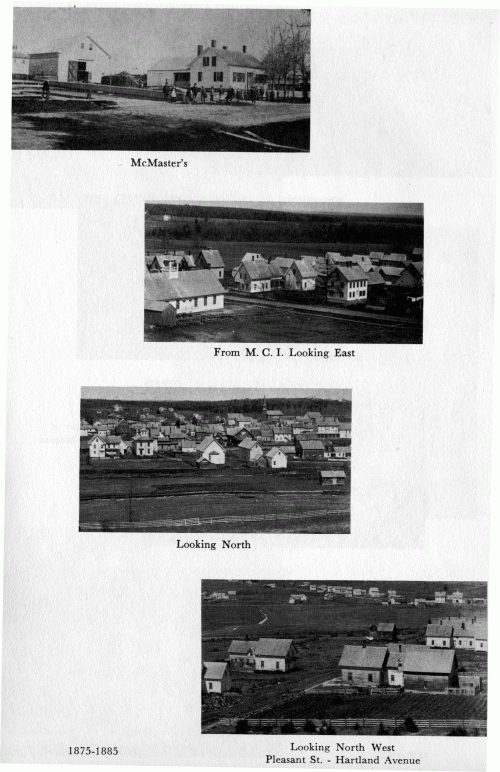
[Page 80.1]
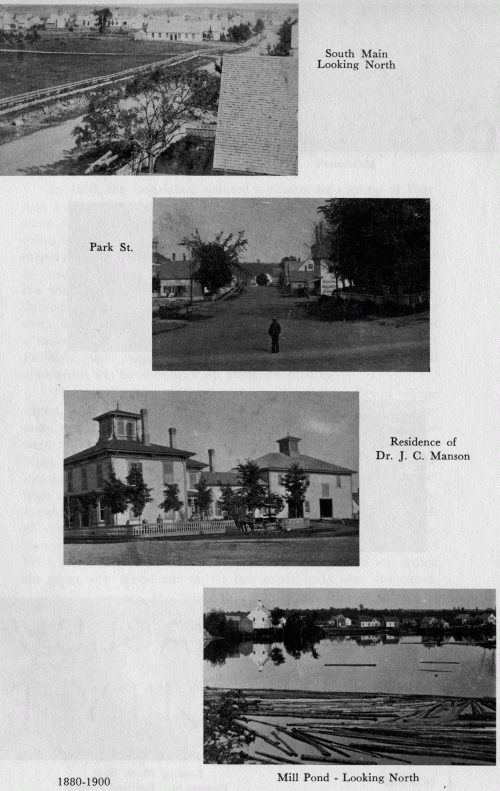
[Page 80.2]

[Page 80.3]

[Page 80.4]
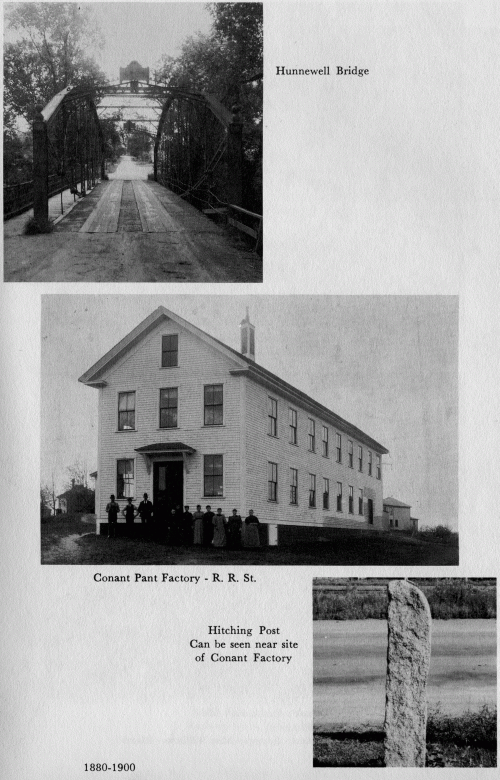
[Page 80.5]
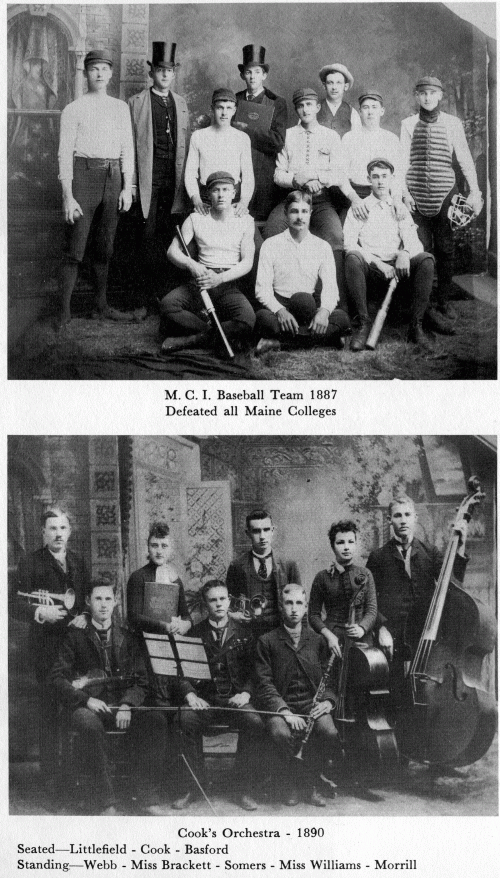
[Page 80.6]
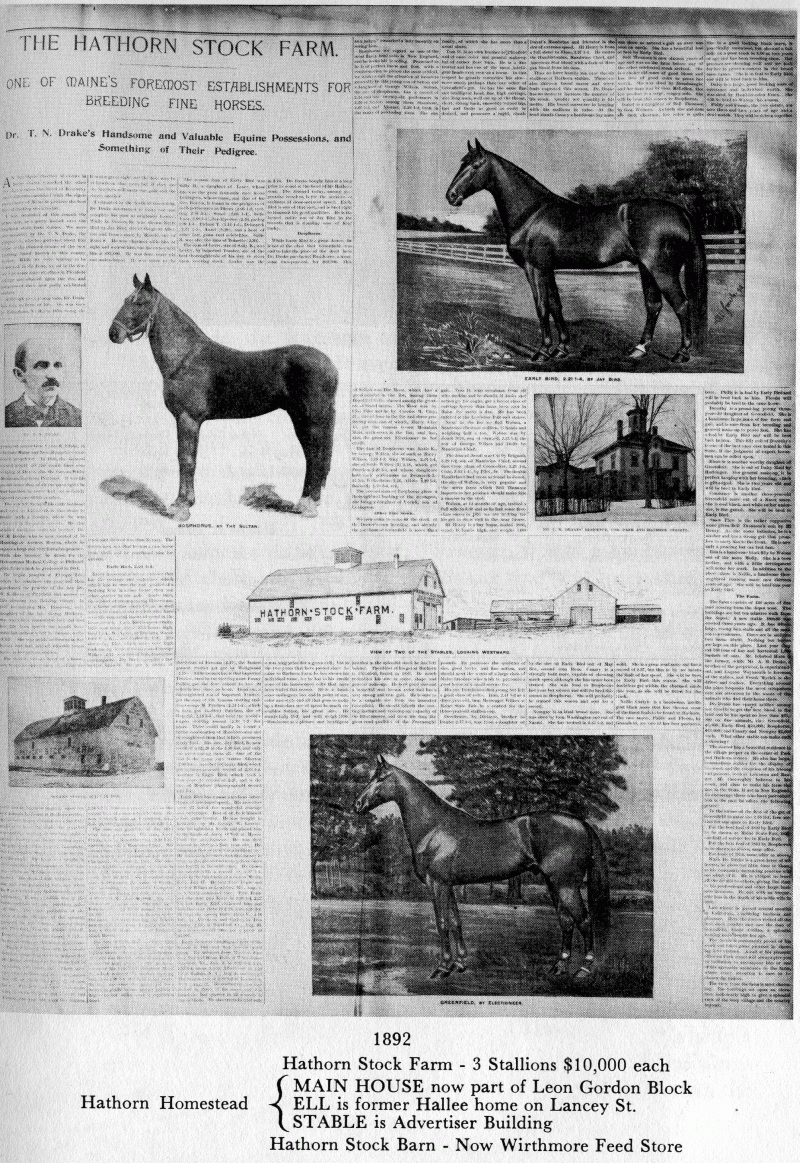
[Page 80.7]
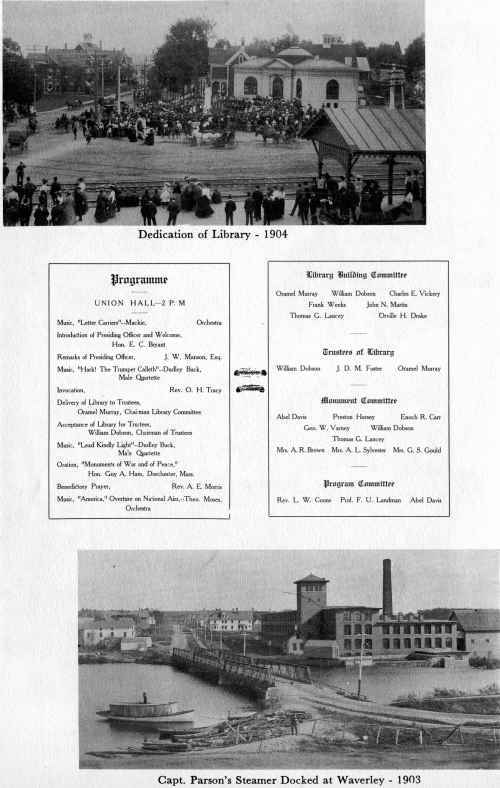
[Page 80.8]
was ready, he turned the wheel. Everything worked as smooth as smelt. Mr. Dobson was heartily congratulated and made some appropriate remarks. Supt. Murray was exuberant, Capt. Baker was as frisky as a colt, the mechanics were pleased and everybody was happy. The Capt. Baker referred to was a businessman from Belfast who had some share in the financing.
The system has continued to expand. At times there have been some warm discussions over rates, etc., but altogether, Pittsfield has been most fortunate to enjoy good water at reasonable costs, thanks to the foresight of our predecessors.
The building of the Waverley Mill and the completion of the Pittsfield Water Works seemed to climax the period we had designated as one of extraordinary growth. The remaining years of this twenty year span continued to be prosperous ones, but they are overshadowed by the size and importance of these two major undertakings. The projects, both private and public, that followed in the next few years were more or less incidental to these two historic achievements. However, it was a great town to live in and there was much accomplished that was interesting and important to the community.
During 1895 and 96, there was considerable discussion among the Universalists about rebuilding their church or at least renovating the old building. This eventually resulted in the construction of a church sanctuary that is unsurpassed in beauty. The I. O. O. F. hall was dedicated in 1895. During the same year, Loder had a greenhouse on R. R. Street; Bryant & Woodruff dissolved partnership and Bryant went on to prosper in wood supplies. He furnished all the window sashes for the Hyde Windlass Company of Bath, among other large orders that he was asked to fill.
A story Mr. Elmore Huff told the writer about the Palmer Bowling Alley at the corner of Central and Middle Streets is amusing. Bowling was beginning to catch on about this time. Mr. Palmer ran the one alley in town. During the day when business was slack, he could usually be found sitting in front of his emporium in a rocking chair with several lines of twine reaching out into the street. On the ends of these lines he knotted a single kernel of corn from the grain store across the street. The doves were plentiful, in fact a nuisance, and Mr. Huff relates that the
81
birds would swallow the corn and then Mr. Palmer would pull them in and eventually have pigeon on his table!
Mr. Huff also mentioned that as a boy he had a high wheeled bicycle which he turned in to a carriage shop across from Palmers and next to the grain mill. He remembers seeing this bicycle placed on the ridgepole of the shop for advertising purposes. Also in 95, the Baptists paid off their $3000 debt; J. C. Connor was planning a new block; Lizzie Walker operated the telephone exchange in the Lancey House; 275 persons patronized the library; Tom Getchell and Blanche Robinson got married; and J. W. Mansons new bathroom is a beauty!
In 96, there was one of the worst floods in history. It rained for 72 hours and the high waters washed out the country roads and small bridges. The new bridges survived without serious damage, much to the satisfaction of the contractors. Town meeting was especially hot this year and in a speech that shook the town officials, J. C. Connor cried, Turn the rascals out! There have been pickings and stealing all along the line! However, not much happened except a few letters to the Editor criticizing Mr. Connor, to which he responded vigorously.
ROBERT DOBSON DIES
In April of this year, the Dobsons were in the spotlight. Gordon bought the bankrupt East Pond Manufacturing Company of Newport for an auction price of $45,000. Later in the month the town was shocked to learn of the death of Robert Dobson. He had gone to Hot Springs for his health. He did not improve and decided to return home. He was met in Washington by Gordon who brought him as far as Boston where he died. His passing again recalled the story of his coming to Pittsfield in 1868, purchasing Going Hathorn’s one-set mill and expanding it into one of the most prosperous industries in the northeast. The funeral was held in Union Hall and more than a thousand friends and business acquaintances attended to pay their respects to one of the finest citizens Pittsfield ever claimed. He had woven his life into the texture of local history with strong and lasting fibers.
Another great Pittsfield family came into the limelight in 1896 when Llewellyn Powers was nominated for Governor. He had
82
been in the public eye for several years as an able attorney and legislator. His campaign, of course, was of great interest to all of Pittsfield and probably one of the biggest political rallies in history was held that September on the M.C.I. campus at which it is estimated 5000 persons attended to hear Thomas B. Reed, who, as Speaker of U.S. House of Representatives, was at the pinnacle of his power. Lawyer Hovey, who seemed to be a master at arranging public meetings, was chairman of the committee that planned and carried out the program of the day. Bands came from Norridgewock and Waterville to help the Pittsfield band stir the crowd with patriotic music. It was a great success and contributed much to the Republican campaign that elected a Pittsfield native Governor of Maine.
POWERS HALL
In the midst of this election fervor, the friends of M.C.I. decided to finish off the open space on the second floor of the Institute building into a beautiful hall to honor Pittsfield’s latest celebrity. By the last of the year the new hall was practically finished and plans were put into operation for an outstanding dedicatory program featuring the presence of the newly inaugurated Governor Powers.
The ceremonies took place February 22, 1897 with dedicatory exercises in the afternoon at the new hall and a reception in the evening. Both the afternoon and evening programs were most successful. The stage was beautifully decorated with patriotic colors and on the platform for the afternoon program were Prof. O. H. Drake, Principal of M. C. I., who presided; President G. C. Chase, Bates College; Hon. A. L. Lumbert, Houlton, M.C.I. 75; Hon. W. W. Stetson, State Superintendent of Schools; Hon. Hannibal Hamlin, Ellsworth; Rev. S. G. Whitcomb, President of the Trustees, M. C. I.; Rev. Roscoe Nelson, Windsor, Connecticut; Dr. M. T. Dodge, Troy; Dr. E. C. Bryant; Dr. F. J. Taylor; J. C. Connor; William Dobson Esq.; Hon. F. W. Hovey, all of Pittsfield.
Following music by the Bowdoin College orchestra, Rev. Whitcomb offered an impressive prayer and Rev. Roscoe Nelson, 85, gave the dedicatory address. Gov. Powers responded feelingly,
83
referring to his boyhood days in Pittsfield and congratulating Pittsfield on its fine town and especially fine school.
The reception in the evening was a charming affair. The entire staff of the Governor was on hand to escort the Governor, his wife and a few friends from the Lancey House. The guest of honor was received in a brilliantly lighted hall by a reception committee consisting of Mrs. S. R. Haines, Mrs. J. W. Manson, Mrs. T. E. Getchell, Miss Ada Coffin, Miss Myra Libby, Mr. Henry F. Libby, Mr. William Dobson, Prof. D. B. Lothrop, Dr. E. C. Bryant, and Dr. T. M. Griffin. At the conclusion of the reception, the Bowdoin Mandolin and Glee Clubs presented a fine concert that was most generously applauded. Miss Addie B. Welch was not on the program but filled in for one of the Bowdoin readers who was unable to appear. She proved to be exceptionally talented and was obliged to respond to the applause with a third reading. It was a most delightful evening to be remembered for many years to come.
BAPTIST 30TH ANNIVERSARY
Before the year of 97 was out, several other events occurred worthy of mention. The Reverend White moved into the new Baptist parsonage and since this was the thirtieth anniversary year of the founding of the Free Baptist Society, the occasion was observed at a Sunday service, January 3rd. Dr. F. J. Taylor gave an excellent history of the church from June 4, 1855, when eight devoted individuals headed by William C. Stinson petitioned the Exeter Quarterly meeting to choose a council for the purpose of organizing a church. The petition was granted and a council chosen consisting of Rev. J. Cook, William Getchell, N. F. Weymouth, John Towne, and John F. Weymouth. An organization was formed and adopted the name of Pittsfield and Detroit Church. The records of this organization are missing and not until Rev. A. L, Gerrish was ordained in 1866 and the first meeting held at Sister Judith Nichols residence January 2, 1867, were permanent records kept. At that time only three members were left of the original organization, Susan Farwell, Judith Nichols, and Mrs. Tuttle, and from this little nucleus, Rev. Gerrish moulded a Baptist Society that has grown continuously over the years.
84
In addition to Dr. Taylors history, a letter from Reverend A. L. Gerrish was read by Mrs. E. C. Bryant and papers were given by O. H. Drake, E. C. Bryant, B. S. Mathews, Mrs. Jennie Randlett, Albert M. Jones, C. F. Lothrop, and Mrs. Lewis.
This was the year we changed Postmasters. Oramel Murray was appointed to the position, relieving H. F. Libby of an office he had held for twelve successive years; plans were discussed to build a Waverley Dam; T. F. Connor completed a beautiful home at the corner of Franklin and Summer Streets, the home of Judge Furbush today.
There had for sometime been a great deal of argument over a narrow gauge R. R. from Wiscasset to Quebec. Actual work on the Wiscasset end had already started and there was much talk of it going through Pittsfield. The roadbed to Burnham was under construction and it appeared to many that at last the road would become a reality. A large crew was at work when an injunction was issued stopping construction and it was never resumed. The old roadbed can still be seen in the Burnham area and is a popular hunting ground in the fall of the year.
Early in the year of 98, two Lancey brothers died, Isaac in March and William K. in April, and their passing recalled the coming of their father to Pittsfield seventy years ago. Their name is indelibly stamped on the records of our town. The three children of the old Colonel who seem to have shared most prominently in the history of Pittsfield were Isaac, who operated the Lancey House; William K., who married Ann Gould and was active in real estate; and Mary, who married Dr. J. C. Manson, and in whose memory their son, John W. Manson, named the Manson Park.
Perhaps the most important project of this year so far as the economy of the town is concerned was the introduction of electric lights to Pittsfield. The Smith-Conant electric power company was ready to start by July and the town voted in August to have street lights and more and more residents subscribed to the service.
J. C. Connor was building a new block this summer; W. R. Hunnewell built his ball grounds and grandstand on Hunnewell Avenue where the Cianchette Brothers are now located; H. C. Hunter was the popular leader of the local band; Harry Cornforth
85
won the Manson Prize; and balloon ascensions were taking place at the Union Park.
The Spanish-American War was on and Dewey had just scored a great victory. Letters were coming home from the boys in the service and among those heard from were Capt. Laforest Graves in Savannah and Bert Ryan who was expecting to go to Havana any day.
UNIVERSALIST CHURCH RENOVATED
Plans for rebuilding the Universalist Church had finally been accepted and the money raised for the renovation. Contractor Wellman moved the old church to the new location, making it into the vestry of the new building and by October the exterior of the edifice was nearly complete. Plans for dedication were being made for next year. Harry Hayman Cochrane of Monmouth, who later became world famous for his church murals, was doing the murals for the new sanctuary.
At the dedication ceremonies, church dignitaries from all parts of the state were in attendance to admire the transformation that had been wrought. It was and still is one of the most beautiful churches to be found anywhere in the state. Its sanctuary is unique in its architectural design and beauty, from its inclined floor which gives an amphitheatre effect to its domed ceiling with its muraled figures representing attributes of God, all softly lighted from three large Tiffany stained glass windows of triptych design. To further enhance the impressive beauty of this sanctuary, are twelve life-sized Cochrane mural masterpieces of Old and New Testament personalities. Today it has become a tourist attraction.
FINANCIAL TROUBLE AT M. C. I.
As the 19th century comes to an end, so, too, concluded a period of unparalleled growth and prosperity. Nearly every segment of our community life seemed to prosper materially with the possible exception of M. C. I., which had financial difficulties during the 80s. Its scholastic standards were never lowered and its enrollment continued to increase, but because of undercharging for the costs of its educational program, the school had trouble in
86
meeting its payments on debts contracted at the time the institution was founded. Things got so bad in the early 80s that in 1881 the Legislature gave the trustees the right to strike out Maine Central and substitute the name of any individual who would give at least $10,000. Mr. Howard Bowen in a study of secondary school education in Somerset County writes: A further provision in the same Act allowed the trustees to move the Institute to some other town where there was not already a Normal School located, if the buildings and grounds at Pittsfield were not free from debt within two years; while additional proof of these difficulties appeared when the trustees voted to see if the teachers would run the Institute for the following year for the tuition. Later they voted to try to dispose of the Institute for the indebtedness and all obligation to anyone who would agree to maintain a school of as high a grade as it is now. This last act evidently stirred the townspeople into action for in a short time a new drive for funds was initiated and was successful in preventing further humiliating financial experiences. Since then, although there have been occasional years of financial worries, the school has always managed to survive and provide superior educational opportunities for the area.
It had been a great century for Pittsfield.
87
|
